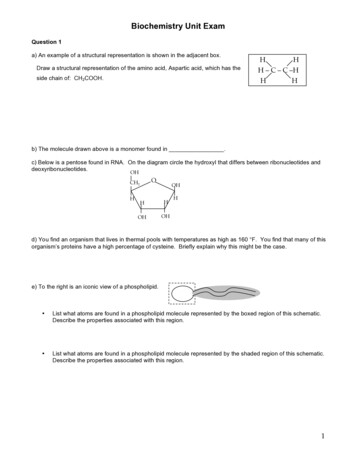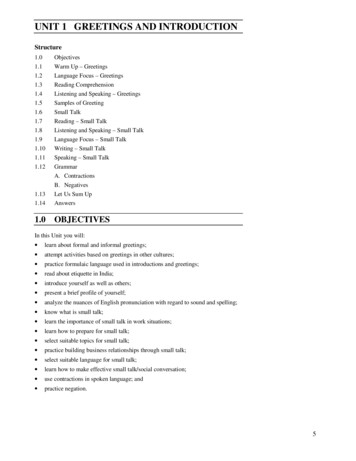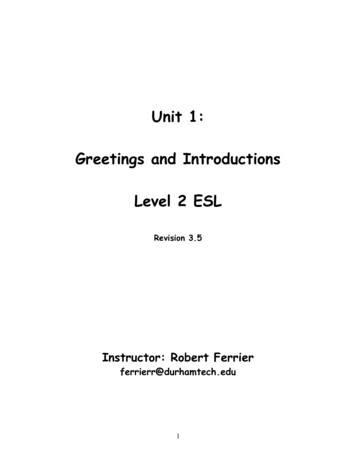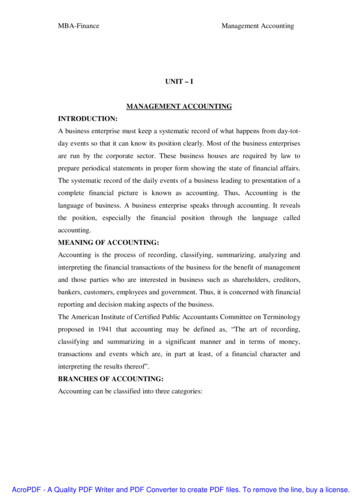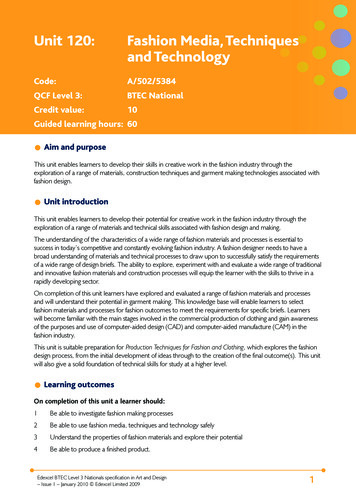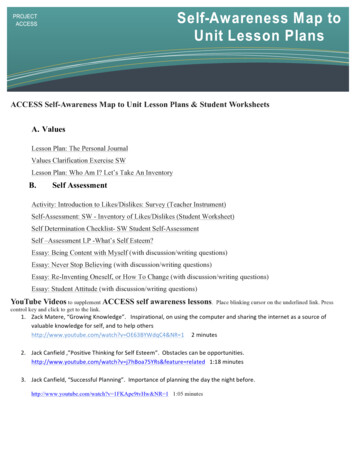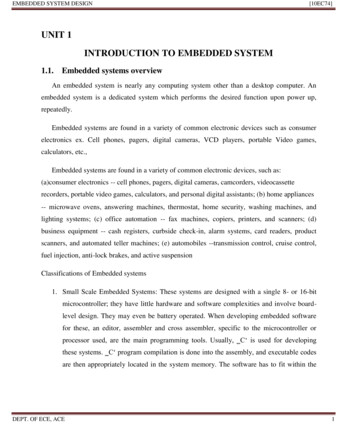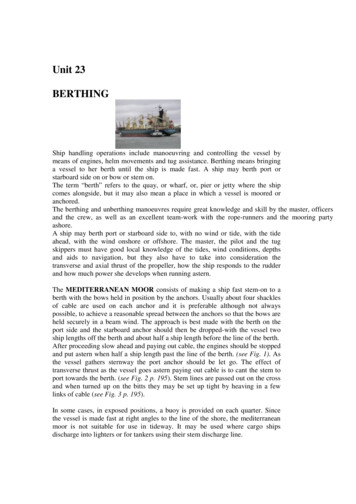
Transcription
Unit 23BERTHINGShip handling operations include manoeuvring and controlling the vessel bymeans of engines, helm movements and tug assistance. Berthing means bringinga vessel to her berth until the ship is made fast. A ship may berth port orstarboard side on or bow or stem on.The term “berth” refers to the quay, or wharf, or, pier or jetty where the shipcomes alongside, but it may also mean a place in which a vessel is moored oranchored.The berthing and unberthing manoeuvres require great knowledge and skill by the master, officersand the crew, as well as an excellent team-work with the rope-runners and the mooring partyashore.A ship may berth port or starboard side to, with no wind or tide, with the tideahead, with the wind onshore or offshore. The master, the pilot and the tugskippers must have good local knowledge of the tides, wind conditions, depthsand aids to navigation, but they also have to take into consideration thetransverse and axial thrust of the propeller, how the ship responds to the rudderand how much power she develops when running astern.The MEDITERRANEAN MOOR consists of making a ship fast stem-on to aberth with the bows held in position by the anchors. Usually about four shacklesof cable are used on each anchor and it is preferable although not alwayspossible, to achieve a reasonable spread between the anchors so that the bows areheld securely in a beam wind. The approach is best made with the berth on theport side and the starboard anchor should then be dropped-with the vessel twoship lengths off the berth and about half a ship length before the line of the berth.After proceeding slow ahead and paying out cable, the engines should be stoppedand put astern when half a ship length past the line of the berth. (see Fig. 1). Asthe vessel gathers sternway the port anchor should be let go. The effect oftransverse thrust as the vessel goes astern paying out cable is to cant the stem toport towards the berth. (see Fig. 2 p. 195). Stem lines are passed out on the crossand when turned up on the bitts they may be set up tight by heaving in a fewlinks of cable (see Fig. 3 p. 195).In some cases, in exposed positions, a buoy is provided on each quarter. Sincethe vessel is made fast at right angles to the line of the shore, the mediterraneanmoor is not suitable for use in tideway. It may be used where cargo shipsdischarge into lighters or for tankers using their stem discharge line.
Forecastledeck – Mooring and Anchoring GearUnmooring manoeuvre
Berth Manager – Jetty Management SystemBased on over 40 years of experience in load andforce measurement, Strainstall’s Berth Managersystem is designed to assist the mooring master byproviding comprehensive surveillance of mooring andvessel-related parameters during approach to theberth, and while moored. Sensors monitor speed ofapproach, mooring loads, weather conditions,oceanographic parameters and detect any drift off. Allof these values are processed and presented on a PCbased control room display system, which providesgraphics and lists of all critical data, and which isavailable on screens in the harbour office and via fibreoptic link or radio to the ship.The Berth Manager jetty management systemintegrates a number of sub-systems which are allavailable as stand alone packages. These systemsare:a)b)c)DockAlert vessel approach monitoring - providesspeed, distance off and drift-off dataMoorAlert mooring load monitoring - providesmooring set-up, mooring tension and alarm dataMeteorological/oceanographic monitoring provides weather and sea-state information forreference
MoorAlert – Mooring Load MonitoringStrainstall’s MoorAlert mooring load monitoring systemprovides an accurate indication of mooring loads in multiline mooring spreads. A vessel’s mooring lines are measuredand monitored by strain gauged load measuring pins,installed in the quick release mooring hooks. This enableseach mooring line to be pre-tensioned according to eachvessel’s individual mooring scheme. The load pins detectany deviation from these defined values and indicate anyalarm conditions. The instrumented hooks and electronicscan be supplied in hazardous area certified form for use onoil and gas jetties, and have been supplied to many port andharbour installations world-wide.DockAlert – Vessel Approach MonitoringThe Strainstall DockAlert vessel approach system usesdistance-measuring lasers on the mooring jetty tocompute the speed of approach, angle of approachand distance off for a vessel being manoeuvred onto adockside mooring. The vessel approach parameterscan be displayed in the harbour office and can also bemade available to the ship’s master via a large digitdisplay on the jetty which is visible from the ship, or viaa data link. With the vessel moored alongside,DockAlert can provide information on drift-off andfender compression. External items can be suppliedcertified for hazardous areas to meet the requirementsof oil & gas jetties.
Towing Load MonitoringThe Strainstall towing load monitoring system isdesigned to give towing vessel masters a directreading of tension in a towing hawser. It consists ofload cells or a load measuring pin fitted to the towinghook, quick release mooring hook or winch, plus areadout/alarm warning unit which can be set withoverload thresholds to suit the gauge of rope or wirebeing used for the towing operation.There are 3 typical towing load monitoringconfigurations: A single channel system with the load pindesigned for incorporation into a swivel joint of atugboat quick release mooring hook For double drum winches, with both outputsleading to a single display unit with a switch toselect the desired measurement channel For marine towing winches, with the load beingmeasured by load cells in the brakestay or underthe bed of the winch.Key features of towing load monitoring include simpleinstallation, full environmental sealing, accuratereadings, easy maintenance and optional additionalreadouts.
Bitts & bollards
IMO STANDARD MARINE COMMUNICATIONPHRASES (IMO SMCP 2001)IV-A/5.7.2 -BerthingAre there any berthing instructions? I What are my berthing instructions?- No berthing instructions.- Berthing on arrival.Your orders are to berth on. .Your orders changed.Proceed to . for orders.You may enter at. UTC.You may proceed at. UTC.Vessel turning/manoeuvring in position. .MV. will turn in position. .MV. will leave. at. UTC.MV . leaving . .MV . entered fairway in position. .Your berth is not clear (until. UTC).Your berth will be clear at. UTC.You will berth/dock at. UTC.Berthing delayed by . hours.Be ready to get underway.Move ahead. metres.Move astern. metres.Have fenders ready fore and aft.We will berth port / starboard side alongside.We will moor to buoy(s) ahead and astern.We will moor alongside.We will moor to dolphins.Send out head/stern/ breast lines.Send out. spring(s) forward / aft.Do you have tension winches?- Yes, we have tension winches (forward and aft).- No, we have no tension winches.Have heaving lines ready forward and aft.Send heaving/ head/ stern/ breast line ashore.The linesmen will use shackles/lashings for securing mooring.Use centre/ Panama lead.Use how lead.Use port quarter/starboard quarter lead.Heave on . line(s)/. spring(s).Pickup slacken . line(s)/. spring(s).Heave away.Stop heaving.Slack away. line(s)/. spring(s).Stop slacking . line(s)/. spring(s). Hold on. line(s)/.spring(s). Heave in easy.
Heave alongside.Keep lines tight.We have to move . metres ahead/astern.Your vessel in position - make fast.We are in position.Make fast fore and aft.Fast forward.Fast aft.Is propeller clear?- Yes, propeller clear.- No, propeller not clear.Keep propeller clear.Line handlers take in mooring linesMooring winchesSingling up the mooring linesCapstan
A. Comprehension & vocabularyA.1 Supply the appropriate term: berthing mooring gear berth berthing operation mooring linesComing along any l. can be a very difficultoperation and is always potentially dangerous. The ship'sanchor and 2. must be made ready for use.Most frequently tugs are used to assist the ship's3. . The Master decides which 4.are to be used. Each officer must knowexactly his own role in the 5. .A2. Explain the movement of the vessel in the followingsentences:1. Take all the way off.2. The vessel starts gathering sternway.3. The vessel moves bow first.
A.3 Sort out the verbs below into two groups:A. - verbs referring to a movement of the line towardsthe person handlingthe lineB. - verbs referring to a movement of the line from theperson handling the line pull the line on board cast off the line run the lineout tighten the line pay out the line heave onthe line slack away the line haul in the line sendaway the line set the line tight, pass the line down to the tug heavethe line take the slack backA (Movement towards the B (Movement away from theperson working the line) person working the line)A B Pull the line on boardCast off the line
A.4 State which of the following terms is described in thesentences below: moor Mediterranean moor berth mooring buoy aids to navigation heaving line mooring gear1. : the place in harbour in which a shiprides to her anchor oris secured alongside.2. : space around a vessel at anchor, and inwhich she willswing freely.3. : buoy securely moored so that a vesselcan be attached to itand lie safely.4. : a type of berth where the ship's stern issecured to the quayand two anchors are laid ahead.5. : a light rope used to haul in a heavierone.6. : buoys, light houses, seamarks,landmarks etc.7. : deck and shore fittings for making fastthe rope.
A.5 Match each phrase with its opposite: unbend the line cast off the line pay outthe line make fast the line slacken the line1. Tighten the line2. Let go the line3. Haul in the line4. Bend the line5.PullthelineonboardA.6 Match each phrase on the left with its synonym on theright:
A.7 Match the pairs of sentences in the two columns below.The first one has been done for you:Berthing at an oil terminalA At the VLCC Jetty there are1 loading arms (16 invhA1fourdiameter) for crude oildischarging and 2x12inch loading arms forbunker loading.B Unberthing and berthing is2 -12 C Pressure: 11possible onlykg/sq.cm.C The crude oil unloading3 10.0 Million Tons/year.capacity isD "T " Jetty: 4x12 in. FMC4 during daytime.loading arms are available forcrude discharge orE If LOA is more than 200m,5 is 0.6 MillionTons/year.F LPG Platform; 1x8 in. FMC6 and their liftingloading arm for LPG, berthingcapacities are up to 1.5only during daytime.tons.Temperature:G The LPG unloading capacity7 berthing is allowedonly during daytime.H Height of vessel's discharge8 to avoid causingmanifold above sea level atdamage to FMCthe end of discharge (withloading arm.permanent ballast) should notI Ship’s height should not be9 be more than 22 m. formore than 18 m. in orderVLCC Jetty No.1J Fixed cranes are available atall berthing points1 loading of black0 product.
A.8 Speaking skills. Work in pairs and talk about what youshould know when you are docking at each berth below:LOA DRAFTBERTHSD.W.T. PRODUCT(m) (m)VLCCJETTY360 -19.2250.000Crude(a)“TJETTY”:285 -16150.000Crude & products(b)BerthNo.1White products & LubBerth No.2 180 -1260.000oilBerth No.3 100 -85.000 ProductsWhite products & LubBerth No.4 100 -63.500oilBlack & whiteCargo Pier 95-63.000 products, luboil,asphaltLPGPlatform:230 -1344.000 LPG(c)103 -6.55.000 LPGBerth No.1Berth No.2(Alternatively students can be given only partialinformation about the berths and they should find thestudent ho has the missing parts of the information)
B. GrammarB. 1 Choose the suitable verb in the brackets and the rightverb form to fill inthe blank spaces:The pilot is explaining the berthing plan at the mooringConference:PILOT - We'll l. heading up stream and 2.the tide. The tugs will be used just to 3.her alongside (stem, push, berth).- CHIEF OFFICER - Where will the tugs 4.(make fast)?PILOT - Starboard side, fore and aft on the main deck.- CHIEF OFFICER - Tug's lines?PILOT - Yes, they 5. you a light wire tohelp them6. in position (give, stay). They 7.us in, so there 8. noneed for a heavy towing spring (be, push,). When we 9.to the berth, we just 10.the current off the jetty and 11. her easegently down on to the berth (stem, get up, let). The first lines12. ashore, via the mooring boat13. two headlines (send, be).
B.2 Supply the right preposition or adverb:- Take the headlines 1. thedrum-ends; no more 2. three turns, and heave 3.(Talking 4. the Bridge). Taking the slack5. on the headlines now.CAPTAIN - Heave easy 6. the headlines. When themooring boat arrives send 7. the spring.Send 8. the breast line and heave it clear 9.the water, but don't put any weight 10. it.We have 15 metres to come 11. .Heave 12. the after back spring. Slack 13.the headropes. Dead 14. ahead.CHIEF OFFICER
B.3 Supply the correct prepositional phrase(equipped with, with drafts up to, according to,just south of, on the outer side, parallel to, inthe center of)BERTHING:Tankers should ask for the berthing time and actinstructions given by the port. Twoberths are available for LPG, four berths for product ,two berths for crude (Max. vessel size : 250,000 DWT).Incoming tankers discharge at a "T" type oil jettythe Tasli Burnu Light. The jetty runsthe coastline and is approximately situated39 39' 30" N, 26 57' 30" E. The outer arm of thejetty, 317 m. long, is designed for crude oil tankers100.000 DWT and for tankers os 25.000DWT on
1 loading arm s (16 invh diameter) for crude oil discharging and 2x12 inch loading arms for bunker loading. A1 B Unberthing and berthing is possible only 2 -12 C Pressure: 11 kg/sq.cm. C The crude oil unloading capacity is 3 10.0 Million Tons/year. D "T " Jetty : 4x12 in. FMC loading arms are available for crude discharge or 4 during daytime.



